Abstract
The search for dark matter is one of the hottest topics in Physics today. The fact that about 80% of the matter of the Universe is of unknown nature has triggered an intense experimental activity to detect this kind of matter and a no less intense effort on the theory side to explain it. Given the fact that we do not know the properties of dark matter well, searches from different fronts are mandatory. Neutrino telescopes are part of this experimental quest and offer specific advantages. Among the targets to look for dark matter, the Sun and the Galactic Center are the most promising ones. Considering models of dark matter densities in the Sun, neutrino telescopes have put the best limits on spin-dependent cross section of proton-WIMP scattering. Moreover, they are competitive in the constraints on the thermally averaged annihilation cross-section for high WIMP masses when looking at the Galactic Centre. Other results are also reviewed.
1. Introduction
During several decades we have been gathering overwhelming experimental evidence of the existence of a new kind of matter, dubbed "dark matter", which constitutes more than 80% of the matter content of the Universe but whose nature is unknown [1,2]. We have proofs of its gravitational effects, but it seems that it does not interact with light. We also know that it should be stable, or at least stable enough to have survived until the current time. There is no candidate in the Standard Model whose properties fits with the properties inferred for this kind of matter, so many alternative theories implying New Physics have have been proposed. Some of these models propose changes in the gravitation theory [3]. Others, instead, assume the existence of a new kind of particle. In this review, we will focus on the latter scenario.
Since we only partially know the properties of this new kind of matter, it is not possible to assure which is the best experimental strategy for its detection. Therefore, a multi-front attack is needed, which includes direct detection experiments, colliders and indirect searches. Indirect searches use gamma rays, cosmic rays and cosmic neutrinos (see [4] for a general review). In this review, we will focus on the experimental basis and results of the searches with neutrino telescopes. Previous reviews on this topic can be found in [5,6]. As will be seen, neutrino telescopes have their own specific advantages and complement other searches.
The structure of this review is as follows. In Section 2, we will describe the detection principle and the main experiments (IceCube, ANTARES, KM3NeT, SuperK). Then, in Section 3, we will review the experimental results obtained for the most promising sources (Sun, Earth, Galactic Centre, galaxy clusters and dwarf galaxies). For the best candidates (Sun and Galactic Centre), a brief digression on the phenomenology will be included. Finally, we will summarize the main conclusions and discuss the prospects for the future in Section 4.
2. Materials and Methods
The basic design of giant neutrino telescopes was proposed by M. Markov [7] in 1961. The idea is to install light detectors at large depths in the sea, lakes or the Antarctic ice (i.e., large volumes of transparent target) in order to detect the Cherenkov light induced by charged leptons produced in the interaction of high energy neutrinos with the matter in/surrounding the instrumented volume. Two main kinds of topologies are possible. On the one hand, tracks produced by muons originated mainly in the charged-current interaction of muon neutrinos. On the other hand, showers are produced after the neutral-current interactions of neutrinos of any flavour or after the charged-current interactions of electron and tau neutrinos. The former allow for a better angular resolution, since they are long tracks which can reach hundreds of metres (depending on the energy), while showers are seen as bright spheres given the granularity of the light sensors in these detectors.
The main background for neutrino telescopes comes from the interaction of cosmic rays in the atmosphere. These interactions produce a huge flux of down-going muons, which severely limits the capacity of these detectors to look for down-going events. Moreover, an almost isotropic background of atmospheric neutrinos is also produced by these interactions, which is dominant among up-going events [8].
As will be described later in this review, neutrino telescopes can be used to look for dark matter since production of neutrinos is expected (typically as secondaries, but in principle also possible as primary yield) after the annihilation or decay of dark matter particles. A detailed discussion about production mechanisms can be found in [9]. An excess of high energy neutrinos in the direction of the sources of interest would be a hint of dark matter accumulation.
- IceCube The IceCube Neutrino Observatory [10] is located at the South Pole. Its instrumented volume is one cubic kilometre, being the largest neutrino telescope to date. It consists of 86 strings, about one kilometre length (from 1450 to 2450 m deep), equipped with 60 Digital Optical Modules (DOMs) each. A DOM contains a 10” photomultiplier (PMT) and the associated electronics for signal processing. It was completed in 2010. As happens with other detectors of this kind, data taking and physics analyses can start as soon as a few lines are installed. The observatory also includes a surface array, called IceTop [11], which can be used as a veto for cosmic rays. Recently, an upgrade with six more lines was added in the internal part of the detector. There are on-going plans for the expansion of the observatory to a larger scale and additional subdetectors [12].
- ANTARES The ANTARES telescope [13] is installed in the Mediterranean Sea, close to the French coast, at a depth of 1450 m. It consists of 12 lines, with a length of 450 m, with 75 Optical Modules (OMs) each (except for one of the lines, partly instrumented with acoustic detectors). It was completed in 2008 and its decommissioning is planned for 2021. Although smaller than IceCube, it offers a better angular resolution, due to the longer scattering length of light in water, and a better visibility of the Galaxy (including the Galactic Centre, particularly important for some of the searches discussed here).
- KM3NeT The KM3NeT Observatory [14] is being constructed in the Mediterranean Sea, in two different locations. The ORCA subdetector is being installed in front of the French coast, at a depth of 2500 m, not far from the ANTARES site, while the ARCA subdetector is being installed off the Sicilian coast at a depth of 3500 m. ORCA, with 115 lines with 60 DOMs each, is denser and smaller (8 MTon), with a low energy threshold (about 3 GeV). ARCA, with 230 lines (longer but also equipped with 60 DOMs each), will have a total volume of about one cubic kilometer. DOMs in KM3NeT are equipped with 31 3-inch PMTs. At the time of this writing, six lines of ORCA and eight lines of ARCA are already installed and taking data, with more lines to be imminently deployed.
- SuperK SuperK [15] is a different concept of detector, although with some similarities with the ones mentioned above. Installed in a mine in Kamioka (Japan), the detector consisted in a pool of purified water (22 kT of fiducial volume) surrounded by PMTs. Its data have been used to look for neutrinos from the Sun, in an energy regime lower than the other detectors described in this review. Recently, Gadolinium has been added to the tank for its optimization for supernova detection.
3. Results
A popular general candidate explaining dark matter are WIMPs (Weakly Interacting Massive Particles), the neutralino being one of the most studied realisations of this possibility, since it can be the lightest super-symmetry particle in SuperSymmetry models [16].
The search for dark matter with neutrino telescopes can be performed for several sources. We can distinguish between two different scenarios, though, as we will discuss later. For sources like the Sun or the Earth, we expect WIMPs present in the Solar System to scatter off nucleons of the Sun or the Earth. These dark matter particles would lose energy and eventually would become gravitationally trapped. Their annihilation with other dark matter particles (if they are assumed to be Majorana particles) would produce (directly or indirectly) high-energy neutrinos. For other sources (Galactic Centre, galaxy clusters, dwarf galaxies …) we would rather expect dark matter particles to have accumulated during the structure formation in these sources just by gravitational attraction. Again, the encounters among these particles would produce neutrinos after their annihilation. It is also possible that dark matter is not stable (although stability at the scale of the age of the Universe is required to ensure its present existence) and decays, producing neutrinos.
In the following, we will review recent results for the sources mentioned above.
3.1. Sun
The Sun is one of the most promising targets for dark matter searches with neutrino telescopes. As mentioned earlier, dark matter particles in the Solar System are expected to occasionally scatter off protons (and neutrons) in the Sun. They would lose energy and become gravitationally trapped. As the density of dark matter particles increases with time, self-annihilation of these particles also increases. At the scales of the Sun’s lifetime, the density will be high enough to reach equilibrium between capture and annihilation.
If we can assume that the capture rate and annihilation cross section are large, we can expect that equilibrium has been reached. The rate of change of the number of WIMPs N(t) in the Sun would be [17]
where is the capture rate, is the annihilation cross-section times the relative WIMP velocity per volume and is the evaporation term, that is, the inverse time for a WIMP to escape (for those with in the tail of large velocities). The evaporation term can be neglected for WIMPs heavier than a few GeV [18].
For the Sun, it can be assumed that equilibrium between capture and annihilation has been reached (), being years [17]:
Therefore, for this case we can set a relationship between the annihilation rate (on which we can set an estimation or a limit from the observation/non-observation of events in our neutrino telescope) and the scattering cross section (since this is related to the capture rate).
Due to the relationship explained above, the searches for neutrino telescopes for dark matter in the Sun set limits in the scattering cross section, as direct searches do. In this sense, neutrino telescopes can be seen as direct search experiments where the Sun is the target. Interestingly, direct searches and neutrino telescopes searches are complementary. Neutrino telescopes are more sensitive to the part of lower velocities of the WIMP velocity distribution (since those WIMPs are more easily captured), while direct searches are more sensitive to the part of higher velocities (since these WIMPs will produce larger signals in the detectors).
Figure 1 shows the recent results of several experiments. As mentioned above, these results can be compared to direct search experiments assuming the aforementioned model. In this scenario, neutrino telescopes (in particular IceCube) offer the best present limit on WIMP-proton spin-dependent cross section. This particular effectiveness of neutrino telescopes for the spin-dependent part comes from the the fact that the Sun is made mainly of protons. The best region for SuperK is at low masses, given its low energy threshold, while for ANTARES, the contrary happens, being much larger than SuperK.
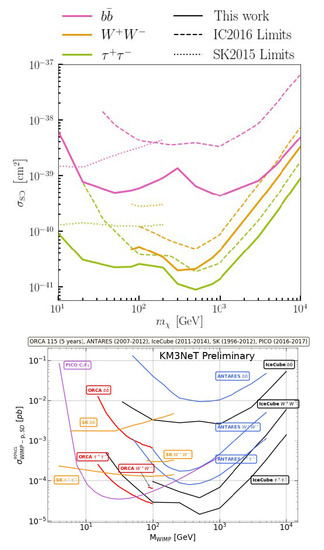
Figure 1.
Limits on the spin-dependent WIMP-proton scattering cross section as a function of the WIMP mass for several channels: (top) Limits from IceCube [19,20] and SuperK [21] (figure reproduced from [19], credit: IceCube collaboration); (bottom) Limits from ANTARES [22] and sensitivity (for five years) for KM3NeT-ORCA [23]; limits from IceCube (3 years of data) [24], SuperK [21] and PICO [25] are also shown (figure reproduced from [23], credit: ANTARES and KM3NeT collaborations).
It should be mentioned that an important advantage of dark matter searches in the Sun by neutrino telescopes is the fact that the astrophysical backgrounds are small, compared to other indirect searches. The only relevant background at these energies would be from the interaction of cosmic rays with the Sun’s corona [26,27], the so-called atmospheric solar neutrinos. Therefore, a potential excess of high energy neutrinos from the Sun would be a very clean signal of dark matter (in opposition to searches with gamma rays, cosmic rays, and so forth, for which the uncertainties in astrophysical backgrounds are larger).
Other interesting searches in the Sun include those looking for secluded dark matter. In these models, dark matter particles can be coupled to Standard Model particles through long lived mediators that can escape from the Sun and decay into SM particles, including muons and neutrinos, which can produce signals in neutrino telescopes. Results for these models for the Sun can be found in [28,29,30].
3.2. Earth
The process for dark matter accumulation in the Earth is similar to what happens in the Sun, with some relevant differences. First, it cannot be assumed that equilibrium between capture and annihilation has been reached at the Earth given its smaller size compared to the Sun, and also to the influence of the latter in the capture process at the Earth.
Moreover, the scattering of dark matter particles occurs mainly with spin-zero nuclei such as Fe, Si and O [4]. Therefore, limits for this case are particularly good for spin-independent scattering cross-section, since it benefits from the dependence of the interaction cross section on the squared atomic number of the target.
Figure 2 shows limits obtained by ANTARES and SuperK and sensitivity of IceCube for dark matter searches in the Earth. Because of kinematics, limits and sensitivities are particularly good for the WIMP masses close to those of the most abundant nuclei.
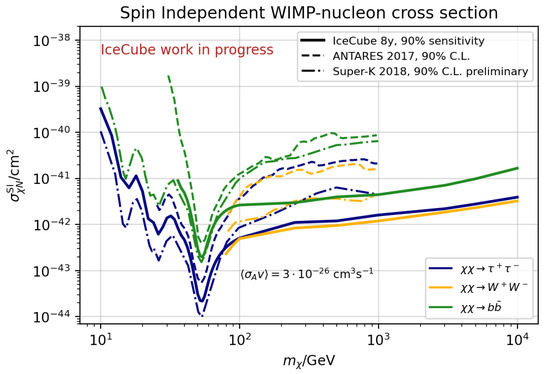
Figure 2.
Limits on the spin-independent WIMP-nucleon scattering cross-section of ANTARES [31], SuperK [32] and sensitivities of IceCube [33] at 90% C.L. Figure reproduced from [33], credit: IceCube collaboration.
3.3. Galactic Centre
The Galactic Centre is an excellent place to look for dark matter using neutrino telescopes. As mentioned above, signals come from the annihilation (or decay) of dark matter particles into neutrinos (directly or, more likely, after the decay of secondaries from those annihilations). Limits are therefore set on the thermally averaged annihilation cross section. Other messengers, such as gamma rays, would also be produced in these processes, but the corresponding searches suffer from large astrophysical backgrounds, so they are focused on other sources such as dwarf galaxies.
The measured flux (or limit on it) can be related to the annihilation cross-section as follows [34]:
where is dark matter particle mass and is the differential number of neutrinos produced per annihilating pair of dark matter particles. Typically, a 100% branching ratio to a given channel of interest is assumed. Among these channels, would represent a soft-spectrum case, while would give a hard spectrum. The so-called J-factor, is defined as
where r is the distance to the Galactic Centre; , the solid angle, and , the dark matter density. Examples of dark matter halo profiles are given by Burkert [35] and by Navarro–Frenk–White [36].
Recent results of searches in the Galactic Centre are shown in Figure 3, where limits to the thermally averaged annihilation cross section are plotted as a function of the WIMP mass. ANTARES, although much smaller than IceCube, has the advantage of being installed in the Northern Hemisphere, which allows for a better visibility of the Galactic Centre. This allows ANTARES to set the best limits on the annihilation cross section among neutrino telescopes for large dark matter masses. As can be seen, the annihilation cross section can also be probed by other indirect searches. Particularly constraining are the limits in the low DM mass region from Fermi-LAT looking at dwarf spheroidals and HESS in the medium mass region looking at the Galactic Centre. It is worth noting that the results from ANTARES are particularly competitive in the region of a very large dark matter mass. In this region, mechanisms to avoid the limits from unitarity [37] have to be claimed (see examples in [9]), but are becoming increasing interesting given the null results from other searches at lower masses, in particular from colliders.
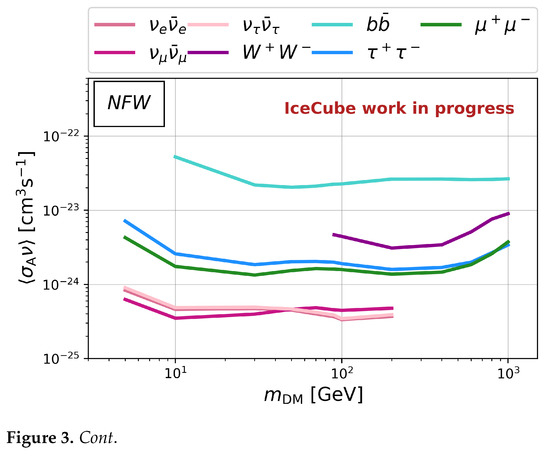
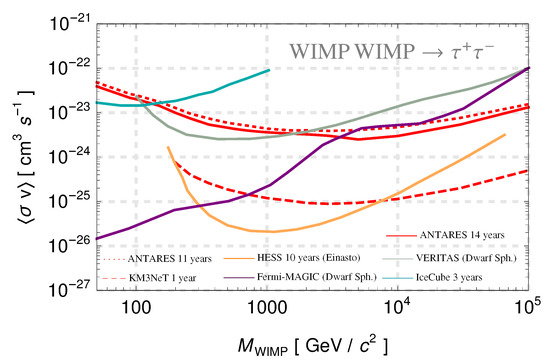
Figure 3.
Upper limits at 90% C.L. on the thermally averaged cross-section for WIMP annihilation as a function of the WIMP candidate mass. top Limits from IceCube [38] for several channels; credit: IceCube collaboration; bottom Limits from ANTARES [39] and sensitivity for KM3NeT-ARCA (one year) [40], compared to other results (IceCube 2017 [41], HESS [42], VERITAS [43] and Fermi-LAT+MAGIC [44]) for the channel and using the NFW halo profile [36] unless indicated otherwise. Figure reproduced from [40]; credit: ANTARES and KM3NeT collaborations.
It is also worth mentioning the analysis carried out jointly by the IceCube and ANTARES collaborations, combining data from both experiments [45]. This allows us to improve by a factor of two the limits in the region where the sensitivities from both experiments are comparable. Moreover, it also represented an opportunity to harmonize analysis tools from both collaborations.
Finally, we would like to mention that sensitivities for secluded dark matter scenarios in the Galactic Center also exist [23].
3.4. Other Sources
Among other possible sources to look for dark matter with neutrino telescopes, we can mention the following: the Galactic Halo, nearby dwarf galaxies and galaxy clusters. Particularly interesting results from these sources come from the searches for dark matter decay. As mentioned earlier, the decay lifetimes should be large enough compared to the age of the Universe so that dark matter has survived in the amounts observed nowadays. Figure 4 summarizes some of these analyses, compared to the limits set by other indirect searches. As can be seen, the IceCube experiment can provide very competitive limits on the lifetime of heavy dark matter particles.
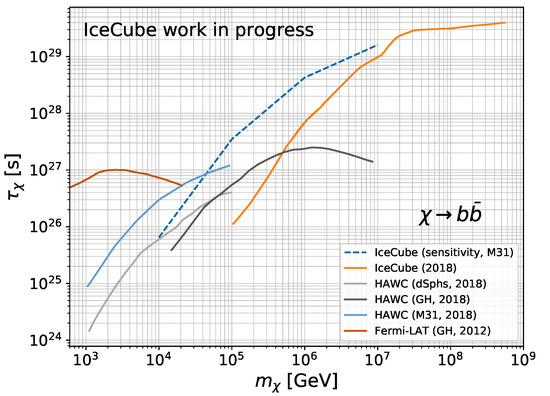
Figure 4.
Limits and sensitivity on decaying dark matter life time from different experiments [46,47,48,49,50]. Figure reproduced from [51], credit: IceCube collaboration.
4. Discussion and Conclusions
No signal of dark matter has been found yet by neutrino telescopes. As we have seen, these detectors have specific advantages and have provided competitive limits in some relevant cases. For searches in the Sun, the astrophysical background is small and well understood. IceCube has set the most stringent limits in the world for WIMP-proton spin dependent cross section. In the Galactic Centre, ANTARES has the advantage of a good visibility of this region, which translates into competitive limits for large masses. This region of large masses in becoming more interesting as searches at lower masses are coming hands empty. For models of decaying dark matter, IceCube has also constrained the heavy dark matter lifetime beyond other searches.
In the future, neutrino telescopes under construction like KM3NeT, HyperK [52], Baikal-GVD [53] will push these limits further, maybe up to the point of discovery. Estimations of the sensitivity of KM3NeT are shown in Figure 1 and Figure 3. In any case, and wherever the first dark matter signal comes from, it will be necessary to study the possible candidates from all the experimental fronts. For this, neutrino telescopes will bring the complementary view discussed in this review.
Funding
The author acknowledges the financial of support of the Ministerio de Ciencia, Innovación, Investigación y Universidades (MCIU): Programa Estatal de Generación de Conocimiento (ref. PGC2018-096663-B-C41) (MCIU/FEDER).
Conflicts of Interest
The author is member of the ANTARES and KM3NeT collaborations.
References
- Bertone, G.; Hooper, D. History of dark matter. Rev. Mod. Phys. 2018, 90, 045002. [Google Scholar] [CrossRef] [Green Version]
- Bertone, G.; Silk, J. Particle dark matter. In Particle Dark Matter; Bertone, G., Ed.; University Press: Cambridge, UK, 2010; pp. 3–13. [Google Scholar]
- Famaey, B.; McGaugh, S. Modified Newtonian Dynamics (MOND): Observational Phenomenology and Relativistic Extensions. Living Rev. Rel. 2012, 15, 10. [Google Scholar] [CrossRef] [PubMed] [Green Version]
- Pérez-de-los-Heros, C. Status, Challenges and Directions in Indirect Dark Matter Searches. Symmetry 2020, 12, 1648. [Google Scholar] [CrossRef]
- Zornoza, J.D. Indirect search for dark matter with neutrino telescopes. In Proceedings of the 14th Marcel Grossmann Meeting on Recent Developments in Theoretical and Experimental General Relativity, Astrophysics, and Relativistic Field Theories (MG14), Rome, Italy, 12–18 July 2015; Bianchi, M., Jantzen, R.T., Ruffini, R., Eds.; World Scientific Publishing: Singapore, 2015; pp. 3257–3261. [Google Scholar]
- Pérez-de-los-Heros, C. The quest for dark matter with neutrino telescopes. In Neutrino Astronomy- Current Status, Future Prospects; Gaisser, T., Karle, A., Eds.; World Scientific: Singapore, 2017; Chapter 11. [Google Scholar]
- Markov, M.A. On high energy neutrino physics. In Proceedings of the 10th International Conference on High Energy Physics (ICHEP 60), Rochester, NY, USA, 25 August–1 September 1960; p. 578. [Google Scholar]
- Gaisser, T.K. The atmospheric neutrino flux. In Probing Particle Physics with Neutrino Telescopes; Pérez de los Heros, C., Ed.; World Scientific: Singapore, 2020; Chapter 3. [Google Scholar]
- Palomares-Ruiz, S. Tests of dark matter scenarios with neutrino telescopes. In Probing Particle Physics with Neutrino Telescopes; Pérez de los Heros, C., Ed.; World Scientific: Singapore, 2020; Chapter 7. [Google Scholar]
- Aartsen, M.G. et al. [IceCube Collaboration] The IceCube Neutrino Observatory: Instrumentation and Online Systems. JINST 2017, 12, P03012. [Google Scholar] [CrossRef]
- Abassi, R. et al. [IceCube Collaboration] IceTop: The surface component of IceCube. Nucl. Instrum. Meth. A 2013, 700, 188–220. [Google Scholar] [CrossRef] [Green Version]
- Aartsen, M.G. et al. [IceCube Collaboration] IceCube-Gen2: The Window to the Extreme Universe. arXiv 2020, arXiv:2008.04323. [Google Scholar]
- Ageron, M.; Aguilar, J.A.; Al Samarai, I.; Albert, A.; Ameli, F.; André, M.; Anghinolfi, M.; Anton, G.; Anvar, S.; Ardid, M.; et al. ANTARES: The first undersea neutrino telescope. Nucl. Inst. Meth. Phys. Res. A 2011, 656, 11–38. [Google Scholar] [CrossRef]
- Adrian-Martinez, S. et al. [KM3NeT Collaboration] Letter of intent for KM3NeT 2.0. J. Phys. G 2016, 43, 084001. [Google Scholar] [CrossRef]
- Fukuda, S. et al. [Super-Kamiokande Collaboration] The SuperKamiokande detector. Nucl. Instrum. Methods A 2003, 501, 418. [Google Scholar] [CrossRef]
- Jungman, G.; Kamionkowski, M.; Griest, K. Supersymmetric dark matter. Phys. Rep. 1996, 267, 195. [Google Scholar] [CrossRef] [Green Version]
- Halzen, F.; Hooper, D. High-energy neutrinos from WIMP annihilations in the Sun. In Particle Dark Matter; Bertone, G., Ed.; University Press: Cambridge, UK, 2010; pp. 507–520. [Google Scholar]
- Griest, K.; Seckel, D. Cosmic asymmetry, neutrinos and the Sun. Nucl. Phys. B 1987, 283, 681–705. [Google Scholar] [CrossRef] [Green Version]
- Lazar, J. Solar WIMP Search with 10 Years of IceCube Data. In Proceedings of the Very Large Volume Neutrino Telescope Workshop 2021, Valencia, Spain, 18–21 May 2021; Available online: https://indico.ific.uv.es/event/3965/contributions/14806/ (accessed on 28 September 2021).
- Aartsen, M.G. et al. [IceCube Collaboration] Improved limits on dark matter annihilation in the Sun with the 79-string IceCube detector and implications for supersymmetry. JCAP 2016, 4, 022. [Google Scholar]
- Choi, K. et al. [SuperKamiokande collaboration] Search for neutrinos from annihilation of captured low-mass dark matter particles in the Sun by Super-Kamiokande. Phys. Rev. Lett. 2015, 114, 141301. [Google Scholar] [CrossRef] [Green Version]
- Adrián-Martínez, S. et al. [ANTARES Collaboration] Limits on dark matter annihilation in the sun using the ANTARES neutrino telescope. Phys. Lett. B 2016, 759, 69–74. [Google Scholar] [CrossRef] [Green Version]
- Gozzini, S.R. et al. [The ANTARES Collaboration] Sensitivity of the ANTARES neutrino telescope for secluded dark matter searches. In Proceedings of the 36th International Cosmic Ray Conference (ICRC2019), Madison, WI, USA, 24 July–1 August 2019; PoS(ICRC2019) 519. p. 519.
- Aartsen, M.G. et al. [IceCube collaboration] Search for annihilating dark matter in the Sun with 3 years of IceCube data. Eur. Phys. J. C 2017, 77, 146. [Google Scholar] [CrossRef] [Green Version]
- Amole, C. et al. [PICO Collaboration] Dark Matter Search Results from the PICO-60 C3F8 Bubble Chamber. Phys. Rev. Lett. 2017, 118, 251301. [Google Scholar] [CrossRef] [Green Version]
- Aartsen, M.G. et al. [IceCube Collaboration] Searches for neutrinos from cosmic-ray interactions in the Sun using seven years of IceCube data. JCAP 2021, 2, 25. [Google Scholar]
- López-Coto, D. et al [ANTARES Collaboration] Solar Atmospheric Neutrinos searches with ANTARES neutrino telescope. In Proceedings of the 37th International Cosmic Ray Conference (ICRC2021), Berlin, Germany, 12–23 July 2021; PoS(ICRC2021) 122. p. 1122.
- Adrian-Martinez, S. et al. [ANTARES Collaboration] Results of the search for Secluded Dark Matter in the Sun with the ANTARES neutrino telescope. JCAP 2016, 5, 16. [Google Scholar]
- Ardid, M.; Felis, I.; Herrero, A.; Martínez-Mora, J.A. Constraining Secluded Dark Matter models with the public data from the 79-string IceCube search for dark matter in the Sun. JCAP 2017, 4, 10. [Google Scholar] [CrossRef] [Green Version]
- Toennis, C. et al. [IceCube Collaboration] Search for secluded dark matter with 6 years of IceCube data. In Proceedings of the 37th International Cosmic Ray Conference (ICRC2021), Berlin, Germany, 12–23 July 2021. PoS(ICRC2021) 521.
- Albert, A. et al. [ANTARES Collaboration] Search for dark matter annihilation in the earth using the ANTARES neutrino telescope. Phys. Dark Univ. 2017, 16, 41–48. [Google Scholar] [CrossRef] [Green Version]
- Mijakowski, P. et al. [Super-Kamiokande Collaboration] Dark Matter Searches at Super-Kamiokande. J. Phys. Conf. Ser. 2020, 1342, 012075. [Google Scholar]
- Renzi, G. et al. [IceCube Collaboration] Search for dark matter from the center of the Earth with 8 years of IceCube data. In Proceedings of the 37th International Cosmic Ray Conference (ICRC2021), Berlin, Germany, 12–23 July 2021. PoS(ICRC2021) 526.
- Yuksel, H.; Horiuchi, S.; Beacom, J.F.; Ando, S.I. Neutrino constraints on the dark matter total annihilation cross section. Phys. Rev D 2007, 76, 123506. [Google Scholar] [CrossRef] [Green Version]
- Burkert, A. Searching the Parameters of Dark Matter Halos on the Basis of Dwarf Galaxies’ Dynamics. Astrophys. J. Lett. 1995, 447, L25. [Google Scholar] [CrossRef] [Green Version]
- Navarro, J.F. The Structure of Cold Dark Matter Halos. Astrophys. J. 1996, 462, 563–575. [Google Scholar] [CrossRef] [Green Version]
- Blum, K.; Cui, Y.; Kamionkowski, M. An Ultimate Target for Dark Matter Searches. Phys. Rev. D 2015, 92, 023528. [Google Scholar] [CrossRef] [Green Version]
- Iovine, N. et al. [IceCube Collaboration] Indirect search for dark matter in the Galactic Centre with IceCube. In Proceedings of the 37th International Cosmic Ray Conference (ICRC2021), Berlin, Germany, 12–23 July 2021. PoS(ICRC2021) 524.
- Albert, A. et al. [ANTARES Collaboration] Search for dark matter towards the Galactic Centre with 11 years of ANTARES data. Phys. Lett. B 2020, 805, 135439. [Google Scholar]
- Lopez-Coto, D. et al. [The KM3NeT Collaboration] Dark Matter Searches from the Sun with the KM3NeT-ORCA detector. In Proceedings of the 36th International Cosmic Ray Conference (ICRC2019), Madison, WI, USA, 24 July–1 August 2019. PoS(ICRC2019) 536.
- Aartsen, M.G. et al. [IceCube Collaboration] Search for neutrinos from dark matter self-annihilations in the center of the Milky Way with 3 years of IceCube/DeepCore. Eur. Phys. J. C 2017, 77, 627. [Google Scholar] [CrossRef]
- Abdallah, H. et al. [HESS Collaboration] Search for Dark Matter Annihilations towards the Inner Galactic Halo from 10 Years of Observations with H.E.S.S. Phys. Rev. Lett. 2016, 117, 111301. [Google Scholar] [CrossRef] [Green Version]
- Archambault, S. et al. [VERITAS Collaboration] Dark matter constraints from a joint analysis of dwarf Spheroidal galaxy observations with VERITAS. Phys. Rev. D 2017, 95, 082001. [Google Scholar] [CrossRef] [Green Version]
- Ahnen, M.L. et al. [MAGIC and Fermi-LAT Collaborations] Limits to Dark Matter Annihilation Cross-Section from a Combined Analysis of MAGIC and Fermi-LAT Observations of Dwarf Satellite Galaxies. JCAP 2016, 2, 39. [Google Scholar]
- Albert, A. et al. [ANTARES and IceCube collaborations] Combined search for neutrinos from dark matter self-annihilation in the Galactic Center with ANTARES and IceCube. Phys. Rev. D 2020, 102, 082002. [Google Scholar] [CrossRef]
- Aartsen, M.G. et al. [IceCube Collaboration] Search for neutrinos from decaying dark matter with IceCube. Eur. Phys. J. C 2018, 78, 831. [Google Scholar] [CrossRef] [PubMed] [Green Version]
- Albert, A. et al. [HAWC Collaboration] Search for dark matter gamma-ray emission from the Andromeda Galaxy with the High-Altitude Water Cherenkov Observatory. JCAP 2018, 6, 043, Erratum in 2019, 4, E01. [Google Scholar]
- Albert, A. et al. [HAWC Collaboration] Dark Matter Limits from Dwarf Spheroidal Galaxies with the HAWC Gamma-Ray Observatory. Astrophys. J. 2018, 853, 154. [Google Scholar] [CrossRef] [Green Version]
- Abeysekara, A.U. et al. [HAWC Collaboration] A search for dark matter in the Galactic halo with HAWC. JCAP 2018, 2, 049. [Google Scholar]
- Ackermann, M. et al. [Fermi-LAT Collaboration] Constraints on the Galactic halo dark matter from Fermi-LAT diffuse measurements. Astrophys. J. 2012, 761, 91. [Google Scholar] [CrossRef] [Green Version]
- Jeong, M. et al. [IceCube Collaboration] A Search for Neutrinos from Decaying Dark Matter in Galaxy Clusters and Galaxies with IceCube. In Proceedings of the 37th International Cosmic Ray Conference (ICRC2021), Berlin, Germany, 12–23 July 2021; PoS(ICRC2021) 506. p. 506.
- Bell, N.F.; Dola, M.J.; Robles, S. Searching for Dark Matter in the Sun using Hyper-Kamiokande. arXiv 2021, arXiv:2107.04216v1. [Google Scholar]
- Avrorin, A.D.; Avrorin, A.V.; Aynutdinov, V.M.; Bannasch, R.; Belolaptikov, I.A.; Bogorodsky, D.Y.; Brudanin, V.B.; Budnev, N.M.; Danilchenko, I.A.; Demidov, S.V.; et al. Neutrino signal at Baikal from dark matter in the Galactic Center. In Proceedings of the International Workshop on Prospects of Particle Physics: Neutrino Physics and Astrophysics, Valday, Russia, 1–8 February 2015. [Google Scholar]
Publisher’s Note: MDPI stays neutral with regard to jurisdictional claims in published maps and institutional affiliations. |
© 2021 by the author. Licensee MDPI, Basel, Switzerland. This article is an open access article distributed under the terms and conditions of the Creative Commons Attribution (CC BY) license (https://creativecommons.org/licenses/by/4.0/).